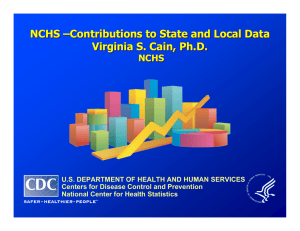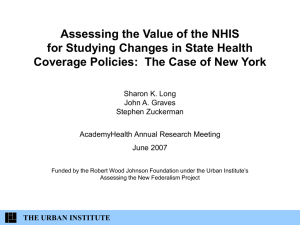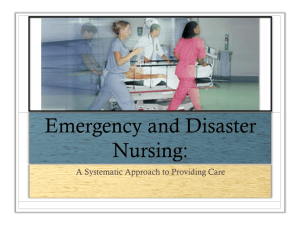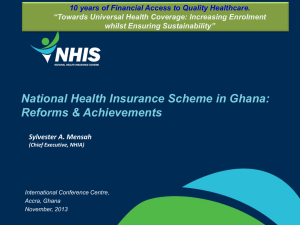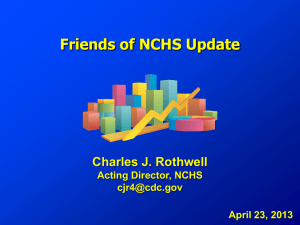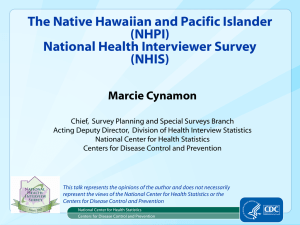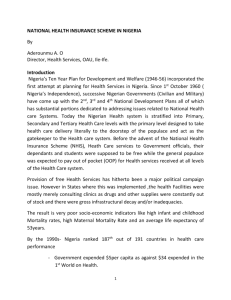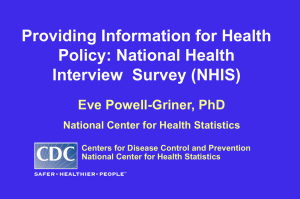NHIS Questionnaire Changes Addressing the Patient Protection and Affordable Care Act Introduction
advertisement
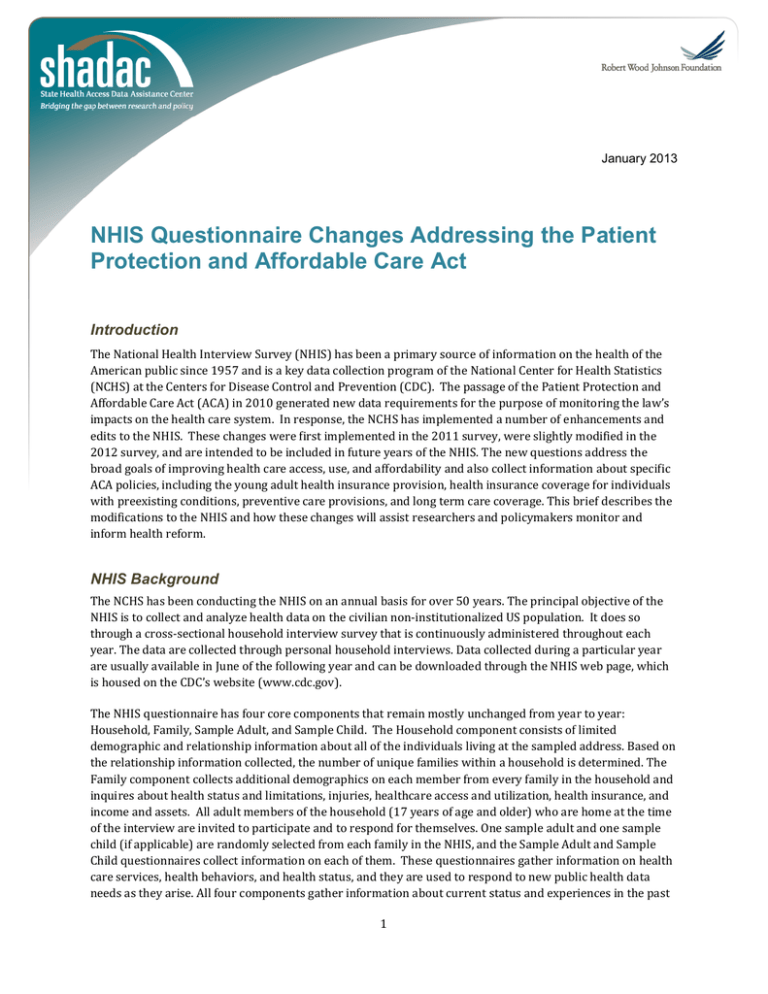
January 2013 NHIS Questionnaire Changes Addressing the Patient Protection and Affordable Care Act Introduction The National Health Interview Survey (NHIS) has been a primary source of information on the health of the American public since 1957 and is a key data collection program of the National Center for Health Statistics (NCHS) at the Centers for Disease Control and Prevention (CDC). The passage of the Patient Protection and Affordable Care Act (ACA) in 2010 generated new data requirements for the purpose of monitoring the law’s impacts on the health care system. In response, the NCHS has implemented a number of enhancements and edits to the NHIS. These changes were first implemented in the 2011 survey, were slightly modified in the 2012 survey, and are intended to be included in future years of the NHIS. The new questions address the broad goals of improving health care access, use, and affordability and also collect information about specific ACA policies, including the young adult health insurance provision, health insurance coverage for individuals with preexisting conditions, preventive care provisions, and long term care coverage. This brief describes the modifications to the NHIS and how these changes will assist researchers and policymakers monitor and inform health reform. NHIS Background The NCHS has been conducting the NHIS on an annual basis for over 50 years. The principal objective of the NHIS is to collect and analyze health data on the civilian non-institutionalized US population. It does so through a cross-sectional household interview survey that is continuously administered throughout each year. The data are collected through personal household interviews. Data collected during a particular year are usually available in June of the following year and can be downloaded through the NHIS web page, which is housed on the CDC’s website (www.cdc.gov). The NHIS questionnaire has four core components that remain mostly unchanged from year to year: Household, Family, Sample Adult, and Sample Child. The Household component consists of limited demographic and relationship information about all of the individuals living at the sampled address. Based on the relationship information collected, the number of unique families within a household is determined. The Family component collects additional demographics on each member from every family in the household and inquires about health status and limitations, injuries, healthcare access and utilization, health insurance, and income and assets. All adult members of the household (17 years of age and older) who are home at the time of the interview are invited to participate and to respond for themselves. One sample adult and one sample child (if applicable) are randomly selected from each family in the NHIS, and the Sample Adult and Sample Child questionnaires collect information on each of them. These questionnaires gather information on health care services, health behaviors, and health status, and they are used to respond to new public health data needs as they arise. All four components gather information about current status and experiences in the past 1 12 months. The enhanced NHIS questions pertaining to the ACA implemented in the 2011 survey are found in the Family, Sample Adult, and Sample Child components. Health Care Access and Use One of the major goals of the ACA is to broaden access to health care by expanding health insurance coverage. For years, the NHIS has included many general questions regarding health insurance coverage status. For example, questions have addressed whether or not a person lacks coverage, type of coverage and reasons for not having coverage. In addition to the existing coverage questions such as type of insurance, months without coverage, reasons for lack of coverage, the 2011 NHIS asks several new questions that will help policymakers track the shared coverage responsibility provision that will begin in 2014. This provision requires all Americans to carry health insurance or be subject to a monetary penalty and requires employers with 50 or more workers to offer coverage or pay a fine. Starting in 2014, health insurance exchanges will be available for individuals and small employers to find, compare, and purchase private health insurance. The 2011 survey asks if an individual has coverage that was directly purchased during the past 3 years (e.g., not through an employer, union, or government program); if so, who in the household was covered by that plan; and whether it was difficult to find the plan. Also in preparation to address this provision, the 2011 survey inquires whether or not an individual had coverage for the past 12 months, how insurance status compares to one year ago, the last type of coverage a person had if they are uninsured at the time, how private insurance was obtained, and several questions regarding employer or union financial contributions toward the health plan. See Table 1 for a list of all new related questionnaire items. Table 1. New NHIS Questions Addressing Health Care Access and Use Instrument Item Name Question Survey Component Universe Data File FHICHNG Did you have coverage for the past 12 months? Family All persons who are currently insured who were continuously covered in the past year Person FHIKDB Last type of coverage person had (if uninsured at present) Family All persons who are currently uninsured for less than a year Person PWRKB Category that best describes how private insurance was obtained Family All persons who had previous private health insurance Person PWRKBSP Enter how private health insurance was obtained. Family All persons who had previous private health insurance obtained from other source Person EMPPAY Do you know how much the employer or union is paying for the plan? Family All private health insurance plans paid for by employer or union Person How much does the employer or union currently pay for health insurance premiums for the plan? Enter time period for premium payments. What percent of the premiums does the employer or union pay for? Family All private health insurance plans where amount of premium employer/union pays is known All private health insurance plans with a valid response to EMPCOSTN All private health insurance plans paid for by employer or union where respondent wanted to report percentage of premium paid Person During the past 3 years, did you try to purchase insurance directly (not through an employer, union or government program)? Was a plan purchased? Sample Adult Sample adults 18+ Sample Adult Sample Adult Sample adults 18+ who tried to purchase health insurance directly in the past 3 years Sample Adult EMPCOSTN EMPCOSTT EMPCOSTP AINDINS AINDPRCH Family Family 2 Person Person Instrument Item Name Question Survey Component Universe Data File AINDWHO Was the plan for self, other person in family, both? Sample Adult Sample adults 18+ who tried to purchase health insurance directly in the past 3 years Sample Adult AINDDIF1 How difficult was it to find a plan with type of coverage you needed? Sample Adult Sample adults 18+ who purchased health insurance directly in the past 3 years Sample Adult AHICOMP In regard to your health insurance, how does it compare to a year ago? Sample Adult Sample adults 18+ Sample Adult Why don't you have a usual source of medical care? During the past 12 months, had trouble finding a general doctor or provider who would see you? Thinking about your most recent ER trip, did you go to the ER either at night or on the weekend? Did ER visit result in hospital admin? Sample Adult Sample adults 18+ without a place of usual care Sample adults 18+ Sample Adult Sample Adult Sample Adult Sample adults 18+ who had at least one ER visit in the past year Sample Adult Sample Adult Which applies to your last ER visit: 1: no place else to go 2: doctor’s office/clinic not open 3: health provider advised you to go 4: problem was too serious for the clinic 5: only a hospital could help you 6: the ER is your closest provider 7: you get most of your care at the ER 8: you arrived by ambulance or other emergency vehicle Were you able to find a general doctor or provider to see you? During the past 12 months, were you told by a doctor’s office or clinic that they would not accept you as a new patient? During the past 12 months, were you told by a doctor’s office or clinic that they did not accept your health care coverage? Thinking about your last visit for any type of medical care, where did you go? Did you see a general doctor, specialist, or someone else? Sample Adult Sample adults 18+ who had at least one ER visit in the past year Sample adults 18+ who had at least one ER visit in the past year and the last visit did not result in a hospital admission Sample Adult Sample Adult Sample Adult Sample adults 18+ who had trouble finding a provider Sample adults 18+ Sample Adult Sample Adult Sample Adult Sample adults 18+ Sample Adult Sample Adult Sample adults 18+ who have ever seen a doctor or other health professional Sample Adult Sample Adult Sample adults 18+ who visited a clinic, doctor's office/HMO, hospital outpatient department or someplace else (not ER or urgent care center) on their last visit Sample Adult For this visit, how long did you have to wait between the time you made the appointment and the day you actually saw the doctor or other health care professional? Enter time period for appointment wait time. Sample Adult Sample adults 18+ who visited a clinic, doctor's office/HMO, hospital outpatient department or someplace else (not ER or urgent care center) on their last visit Sample Adult Sample Adult Sample adults 18+ who visited a clinic, doctor's office/HMO, hospital outpatient department or someplace else (not ER or urgent care center) on their last visit and did not answer refused to appointment wait time Sample Adult How long did you have to wait in the waiting room before you saw a doctor or health professional? Time period in waiting room. Sample Adult Sample adults 18+ who had a place of last medical visit Sample Adult Sample Adult Sample adults 18+ who had a place of last medical visit and did not refuse number portion of waiting room time Sample Adult ANOUSLPL APRVTRYR AERVISND AERHOS AERREAS1 through AERREAS8 APRVTRFD ADRNANP ADRNAI AVISLAST Sample Adult Sample Adult ALASTTYP AVISAPTN AVISAPTT AWAITRMN AWAITRMT 3 Instrument Item Name HIT1A through HIT5A CNOUSLPL CERVISND CERHOS CERREAS1CERREAS8 CPRVTRYR CPRVTRFD Question Survey Component Universe Data File During past 12 months, have you used computers to: 1: look up health information on the internet 2: fill a prescription 3: schedule appointment with provider 4: communicate with provider via email 5: use online chat groups to learn about health topics? Why child doesn’t have a usual source of care? Thinking about the sample child's most recent ER visit, did he/she go to the ER either at night or on the weekend? Did this ER visit result in hospital admission? Sample Adult Sample adults 18+ Sample Adult Sample Child Sample children < 18 without a place of usual care Sample children < 18 who had at least one ER visit in the past year Sample Child Sample Child Sample Child Sample children < 18 who had at least one ER visit in the past year Sample Child CERREAS1-CERREAS8 : Reasons for ER visit : 1: Didn't have another place to go 2: Doctor's office or clinic was not open 3: Health provider advised that he/she go 4: The problem was too serious for the doctor's office or clinic 5: Only a hospital could help him/her 6: The ER is his/her closest provider 7: He/she gets most of his/her care at the ER 8: He/she arrived by ambulance or other emergency vehicle In the past 12 months did you have trouble finding a general doctor or provider who would see your child? Were you able to find a doctor or provider who could see the child? Sample Child Sample children < 18 who had at least one ER visit in the past year which did not result in a hospital admission Sample Child Sample Child Sample children < 18 Sample Child Sample Child Sample children < 18 who had trouble finding a provider in the last year Sample Child Sample children < 18 Sample Child Sample children < 18 Sample Child Sample Child During past 12 months were you told Sample Child by a doctor’s office or clinic that they CDRNANP would not accept the child as a new patient? During past 12 months were you told Sample Child CDRNAI by a doctor’s office that they did not accept child’s health coverage? Source: http://www.cdc.gov/nchs/nhis/quest_data_related_1997_forward.htm For many years, the NHIS has also asked questions about access to health care. For example, the survey asks respondents about whether or not they have a usual place for medical care, what kind of place that is, and if that place is the same as where they go when they are sick, rather than just for preventive services. The 2011 NHIS added questions to this section about why respondents did not have a usual source of medical care when relevant, offering a range of possible reasons such as language problems, convenience, and cost. The survey also extended the questions about usual source of care to Sample Child respondents. Historically, the NHIS has also measured health care access and use in terms of emergency room (ER) visits by both adults and children, including an individual’s number of visits in the past 12 months, if the individual had any visit to the ER in the past 12 months for asthma, and whether the ER was an individual’s usual place for medical care. The new NHIS questions ask if an individual’s most recent ER visit was at night or on the 4 weekend, if the ER visit resulted in a hospital admission, and the reasons why an individual visited the ER. As shown in Table 1, these questions were asked of both sample adults and children. Delaying needed health care is another measure of health care access and use. In the past, the NHIS has included questions to examine why people delay care, such as because they couldn’t get an appointment soon enough, no doctor office was open, they couldn’t get through to their health care clinic by phone, they lacked transportation, or they waited too long in the office. In 2011, the survey began to track specific reasons for why survey respondents experienced limited access to care. For example, for adults and children, the survey now asks whether the individual was told that the clinic or provider was not accepting new patients or that their health insurance wasn’t accepted by the provider. The 2011 NHIS also follows-up on whether the individual was able to find a general doctor despite such troubles and the waiting times experienced to obtain an appointment and in the waiting room during an appointment. New access and use measures in the NHIS also examine the role of technology. There are now several questions about whether individuals used computers to look up health information, fill prescriptions, schedule appointments, communicate with providers, or use chat groups to learn about health topics. The full list of all new access and use measures is found in Table 1. Affordability Another broad goal of the ACA is to improve health care affordability. For several years, the NHIS has asked if respondents had to delay medical care due to cost and if they needed but couldn’t afford medical care, dental care, eyeglasses, prescription medicines, and mental health care. As shown in Table 2, beginning in 2011 the NHIS began asking whether or not individuals needed but could not afford follow-up care or specialist visits, worried about paying medical bills, asked their doctor to lower the cost of medical bills, and/or did any of the following to save money on prescriptions: delayed refilling prescriptions, purchased medication from other countries, took less medication or skipped doses, or used alternative therapies. The new questionnaire also includes items to gauge how confident people are in their ability to afford health insurance and care should they become ill or need to purchase their own coverage. Specifically, the questions ask how confident people would be about being able to obtain affordable coverage if they had to buy an insurance plan on their own, how worried they are about paying medical bills should they be in an accident or get sick, and if they currently are having or recently had trouble with medical bills. Finally, the new survey asks how difficult it was for an individual to find a health insurance plan with the type of coverage that they could afford. The full list of enhanced affordability questions is found in Table 2. 5 Table 2. New NHIS Questions Addressing Affordability Instrument Item Name FCOVCONF MEDBILL MEDBPAY MEDBNOP PLNBUR ARXPR_1 through ARXPR_6 AWORPAY AHCAFY_5 AHCAFY_6 AINDDIF2 Survey Component Question Universe Data File If you had to buy a health plan on your own, with no help from an employer, how confident are you that you would be able to obtain affordable coverage? In the past 12 months, did you have problems paying medical bills? Are you currently paying off bills over time? Family All families with an employer-based health plan Family Family All families Family Family All families Family Do you currently have medical bills that you are unable to pay? Has the cost of the premiums for the health insurance plan caused financial problems for the family? ARXPR_1 through ARXPR_6 Regarding prescription medications, during the past 12 months did you do any of the following to save money? _1 skip doses _2 take less medicine _3 delay filling a prescription _4 ask your doctor for a lower cost medicine _5 buy prescription drugs from another country _6 use alternative therapies If you get sick or have an accident, how worried are you that you will be able to pay your medical bills? During the past 12 months, was there any time when you needed specialist care but didn't get it because you couldn't afford it? During the past 12 months, was there any time when you needed follow-up care but didn't get it because you couldn't afford it? How difficult was it to find a plan with the type of coverage you could afford? Family All families Family Family All private health insurance plans Person Sample Adult Sample adults 18+ Sample Adult Sample Adult Sample adults 18+ Sample Adult Sample Adult Sample adults 18+ Sample Adult Sample Adult Sample adults 18+ Sample Adult Sample Adult Sample adults 18+ who purchased health insurance directly in the past 3 years Sample children < 2 Sample Adult Sample children >/= 2 Sample Child Sample children < 2 Sample Child Sample children >/= 2 Sample Child During the past 12 months, was there any time Sample Child when your child needed follow-up care but didn't get it because you couldn't afford it? During the past 12 months, was there any time Sample Child CHCAFYR6 when your child needed follow-up care but didn't get it because you couldn't afford it? During the past 12 months, was there any time Sample Child CHCAFYRN when your child needed to see a specialist but didn't get to because you couldn't afford it? During the past 12 months, was there any time Sample Child CHCAFYR5 when your child needed to see a specialist but didn't get to because you couldn't afford it? Source: http://www.cdc.gov/nchs/nhis/quest_data_related_1997_forward.htm CHCAFYRF Sample Child Young Adult Provision As of 2010, the ACA allows a young adult to remain on his/her parent’s health insurance plans until his/her 26th birthday. There are several existing variables in the NHIS that, when used with new survey questionnaire items, will help researchers determine who was impacted by the young adult provision of the ACA. For example, questions on age, insurance status, reason for lacking insurance, and type of insurance have been part of the survey for many years, but in 2011 the NHIS began asking questions to help identify those insured young adults who were still on their parents’ plan. As shown in Table 3, the new NHIS 6 questionnaire asks if respondents were related to the policyholder under whom they were insured, whether an insurance plan covered anyone outside of the household, the number and relationship of those people covered under the plan who live somewhere else, and the number of children covered by the plan who live somewhere else. Another variable relevant to this ACA provision is based on the new survey question that asks if an individual is currently uninsured or had a period without coverage in the past year (or changed health insurance in the past year). The question requires respondents to select the type of coverage they had before that period. Table 3. New NHIS Questions Addressing the Young Adult Provision Instrument Item Name Question Survey Component Universe Data File PRCOOH Does this plan cover anyone who doesn’t live here? Family All private health insurance plans with policyholder on family roster Family How many people does this plan cover who live somewhere else? Family All private health insurance plans with policyholder on family roster that cover someone outside the family roster Family PRCTOH What is the relationship of this person to the policyholder? Family All private health insurance plans with policyholder on family roster that cover someone outside the family roster Person PRRELOH How old is the first child? Next child? Family All private health insurance plans with policyholder on family roster that cover one or more children not on the roster Person Family All private health insurance plans Person Family All private health insurance plans with policyholder on family roster that cover a child or children not on the roster Person PRCNUM Does this plan require you to have a primary care doctor or group of doctors for all routine care? How many children are covered who live elsewhere? How are you related to the policyholder? Family All persons on each plan where the policyholder is outside of the family roster Person PRPOLH PRAGEOH1, PRAGEOH2 PCPREQ Source: http://www.cdc.gov/nchs/nhis/quest_data_related_1997_forward.htm Preexisting Conditions An additional provision of the ACA that began in 2010 is the Preexisting Condition Insurance Plan (PCIP), which provides access to health insurance for children with preexisting conditions whom have been uninsured for at least six months. Beginning in 2014, this provision will protect adults from being denied coverage if they have a preexisting condition. In the past, the NHIS has included questions about a variety of chronic conditions, such as diabetes, hypertension, arthritis-related conditions, high cholesterol, asthma, and heart disease. However, prior to 2011, no questionnaire items captured whether a person had been denied coverage, charged a higher price because of health status, or excluded from coverage because of a specific health problem. These variables, as well as a question asking about the reasons why those lacking insurance had not purchased a health insurance plan (including due to a pre-existing condition), were added in 2011 to the NHIS, and are summarized in Table 4. 7 Table 4. New NHIS Questions Addressing the Preexisting Condition Provision Instrument Item Name AINDENY1 AINDENY2 AINDENY3 Question Survey Component Data File Did any company turn you down when you tried to buy coverage on your own? Sample Adult Sample adults 18+ who purchased health insurance directly in the past 3 years Sample Adult Did any company charge a higher price because of your/your family’s/you or your family’s health? Sample Adult Sample adults 18+ who purchased health insurance directly in the past 3 years Sample Adult Did any company exclude specific health problem from the coverage? Sample Adult Sample adults 18+ who purchased health insurance directly in the past 3 years Sample Adult Why did you not buy a plan? Sample Adult Sample adults 18+ who tried to purchase health insurance directly in the past 3 years but did not Sample Adult Specify other reason plan was not obtained. Sample Adult Sample adults 18+ who had other reason plan was not purchased Sample Adult AINDNOT AINDNTSP Universe Source: http://www.cdc.gov/nchs/nhis/quest_data_related_1997_forward.htm Preventive Care Effective 2010, the ACA requires all new group and individual health plans to provide free preventive care for recommended preventive services and immunizations. In the past, the NHIS did not include questions about individuals’ recent use of preventive services. For example, respondents were asked if they had ever had a mammogram, been tested for colon cancer, had their blood cholesterol checked by a health professional, been tested for diabetes, or been talked to by a health professional about diet and smoking. In 2011, the NHIS questionnaire included questions asking about whether adults had received these preventive services in the past twelve months (see Table 5). Table 5. New NHIS Questions Addressing the Preventive Care Provision Instrument Item Name Survey Component Question Universe Data File APSBPCHK During the past 12 months, have you had your blood pressure checked? Sample Adult Sample adults 18+ Sample Adult APSCHCHK During the past 12 months, have you had your cholesterol tested? Sample Adult Sample adults 18+ Sample Adult APSBSCHK During the past 12 months, have you had a fasting test for high blood sugar or diabetes? Sample Adult Sample adults 18+ Sample Adult During the past 12 months, have you had a Pap smear? Sample Adult Female sample adults 18+ Sample Adult APSMAM During the past 12 months, have you had a mammogram? Sample Adult Female sample adults 30+ Sample Adult APSCOL During the past 12 months, have you had a colon cancer test? Sample Adult Sample adults 40+ Sample Adult During the past 12 months, has a doctor/health professional talked to you about your diet? Sample Adult Sample Adult During the past 12 months, has a doctor/health professional talked to you about smoking? Sample Adult Sample adults 18+ who currently smoke every day or some days Sample adults 18+ APSPAP APSDIET APSSMKC 8 Sample Adult DISHFAC If you wanted to use one, is there a health club, wellness program or fitness facility in your area that meets your needs, if you wanted to use one? Sample Adult Sample adults 18+ Sample Adult Reason your access to a health club, wellness program, or fitness facility that meets your needs is limited? Sample Adult Sample Adult During the past 12 months, have you used a health club, wellness program, or fitness facility at least 10 times? Sample Adult Sample adults 18+ who do not have access to a health club, wellness program, or fitness facility that meets their needs, if they want to use one Sample adults 18+ DISHFL02DISHFL07 DISHFUSE Sample Adult Source: http://www.cdc.gov/nchs/nhis/quest_data_related_1997_forward.htm The NHIS has always included questions about exercise, but the new questionnaire includes specific questions about the use of health clubs as well. In addition to tracking whether or not an individual has access to a health club, wellness program, community recreation program, or employer fitness program, the survey also now asks about limitations preventing the use of these resources. Long-term Care Insurance Program The ACA would have established a national, voluntary insurance program for purchasing community living assistance services and supports (CLASS), but this provision was reported to be dropped in October 2011. As summarized in Table 6, the revised NHIS questionnaire includes new questions on individuals’ need for assistance with activities of daily living (ADLs). Prior to the questionnaire changes, the NHIS asked whether or not an individual received or had unmet need for assisted living, and it had many questions related to sources of activity limitations, both for adults and children. New survey questions seek to determine first if people would be willing to purchasing insurance for a government-run program that helps provide monetary compensation for ADLs. Another question asks how much an individual would be willing to pay per month in order to receive such services later in life. Also, beginning in 2011, the survey asks if the respondent currently has relatives who have needed help with ADLs for at least a year, if he/she personally will need help with ADLs soon, and who he/she would turn to for assistance. 9 Table 6. New NHIS Questions Addressing the Long-Term Care Insurance Program Provision Instrument Item Name Survey Component Question Universe Data File Sample Adult Sample adults 40-65 LTCFAM Do you have a parent, spouse, sibling or adult child who has needed help for at least a year with everyday needs like bathing, dressing, or eating due to a long term condition? Sample Adult LTCHELP How likely is it that you may someday need help with ADLs? Sample Adult Sample adults 40-65 Sample Adult If you needed help, who would provide it? Sample Adult Sample adults 40-65 Health care reform establishes a voluntary, government-run insurance program to pay for help with everyday needs. People will be able to enroll and pay a monthly premium. Once they need care they would receive an average of $50 each day. Would you be interested in purchasing this? How much would you be willing to pay per month NOW to receive this benefit later in life? Sample Adult Sample adults 40-65 Sample Adult Sample Adult Sample Adult How likely would it be for you to pay $100 per month for this insurance? Sample Adult Sample adults 40-65 who would be interested in purchasing long-term care insurance or don't know if they are interested Sample adults 40-65 who don't know how much they would be willing to pay per month for long-term care insurance LTCWHO LTCPRCH LTCPAY LTC100M Sample Adult Sample Adult Source: http://www.cdc.gov/nchs/nhis/quest_data_related_1997_forward.htm Conclusions In 2011, the NHIS added new questionnaire items to assist researchers and policymakers monitor the impacts of the ACA. These measures address both general goals of the ACA, such as health care access, use, and affordability, as well as specific provisions that have already been implemented or will be implemented. These additions, coupled with other changes to NHIS including sample design modifications and an increased sample size, will augment the survey’s ability to produce estimates for more subpopulations and make it an even more valuable data source for examining health and health care in the U.S. Sources NHIS questionnaires, datasets and related documentation. Available at: http://www.cdc.gov/nchs/nhis.htm. Decker, Sandra (2012). Upcoming Changes to the National Ambulatory Medical Care Survey (NAMCS) and the National Health Interview Survey (NHIS). Presentation at the 2012 Conference of the American Society of Health Economists, Minneapolis, MN. 2011 National Health Interview Survey (NHIS) Public Use Data Release. NHIS Survey Description. Division of Health Interview Statistics, National Center for Health Statistics, Hyattsville, MD. June 2012. Available at: ftp://ftp.cdc.gov/pub/Health_Statistics/NCHS/Dataset_Documentation/NHIS/2011/srvydesc.pdf. Minnesota Population Center and State Health Access Data Assistance Center, Integrated Health Interview Series: Version 5.0. Minneapolis: University of Minnesota, 2012. Available at: http://www.ihis.us. 10 Suggested Citation State Health Access Data Assistance Center. 2013. “NHIS Questionnaire Changes Addressing the Patient Protection and Affordable Care Act.” Issue Brief #34. Minneapolis, MN: University of Minnesota. About SHADAC The University of Minnesota’s State Health Access Data Assistance Center (SHADAC) is funded by the Robert Wood Johnson Foundation to collect and analyze data to inform state health policy decisions relating to health insurance coverage and access to care. For information on how SHADAC can assist your state with small area estimation or other data issues relevant to state health policy, please contact us at shadac@umn.edu or call 612-624-4802. 11
